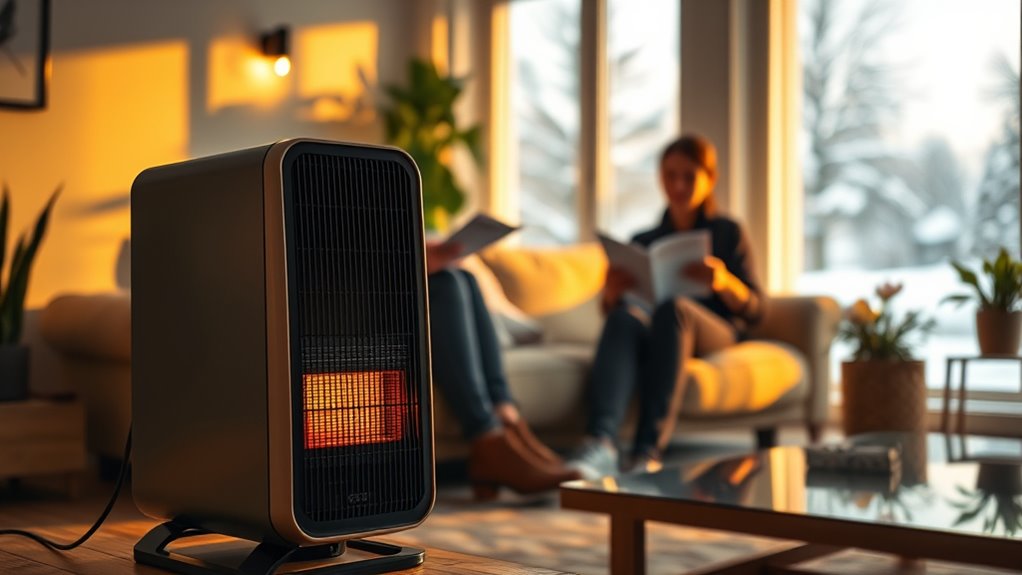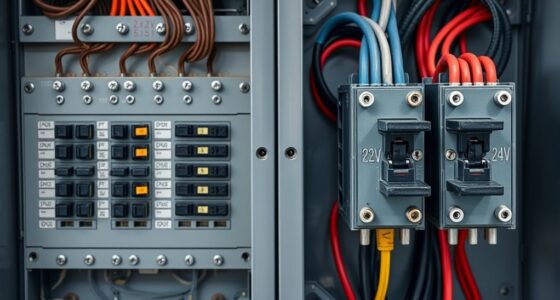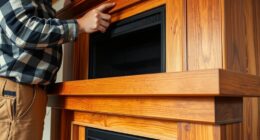To master energy myths about space heater safety in a weekend, start by understanding the latest safety features like automatic shut-off, tip-over protection, and cool-touch exteriors. Learn to recognize safe versus unsafe models, prioritize proper placement, and follow maintenance routines. Use energy-saving tips such as thermostats and insulation, and know how to minimize fire risks. Keep yourself equipped with expert advice and safety protocols to stay informed and confident—more insights await if you keep going.
Key Takeaways
- Research modern safety features like tip-over switches and auto shut-offs to distinguish myths from real safety standards.
- Verify heater labels and certifications to ensure compliance with safety regulations and standards.
- Avoid outdated info by consulting reputable sources, manufacturers, or safety organizations about current space heater safety.
- Understand proper placement, maintenance, and usage practices to prevent hazards and dispel misconceptions.
- Recognize energy-efficient options and safety innovations, including AI detection, to make informed decisions quickly.
Common Myths About Space Heater Safety Debunked
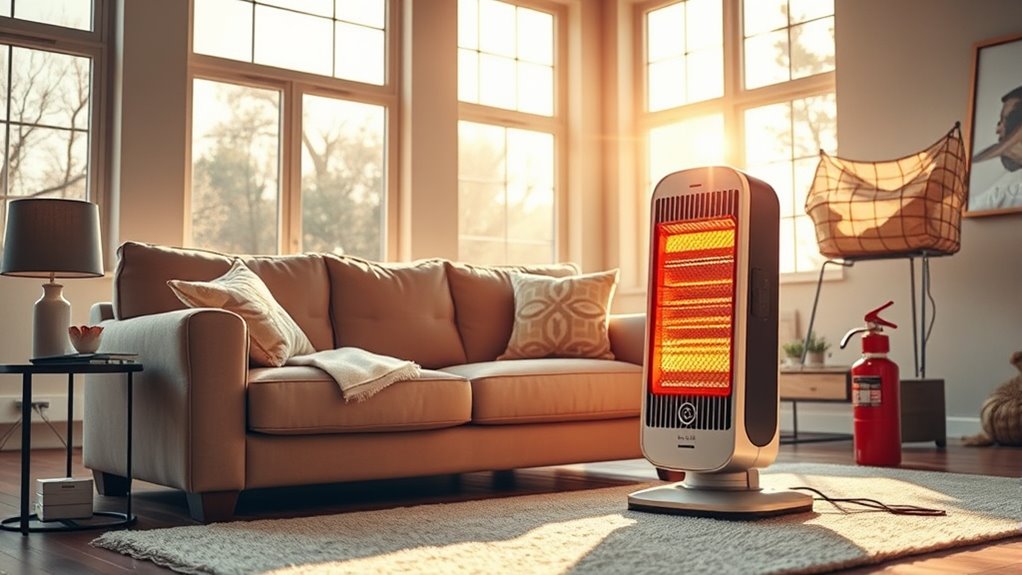
Many people believe that space heaters are inherently dangerous, but most safety concerns are myths. The origins of these myths often stem from outdated information or misunderstood incidents. For example, some think that all space heaters easily cause fires, but modern models come with safety labels that specify their safe use. These labels include important features like automatic shut-off mechanisms, tip-over protection, and certified electrical standards. Understanding where these myths originate helps you realize that reputable space heaters are designed with safety in mind. If you pay attention to safety labels and follow the manufacturer’s instructions, you considerably reduce risks. Additionally, modern design features help prevent common hazards associated with space heater use. So, don’t let unfounded fears prevent you from safely enjoying the warmth and comfort a space heater provides.
Recognizing Safe and Unsafe Space Heater Features
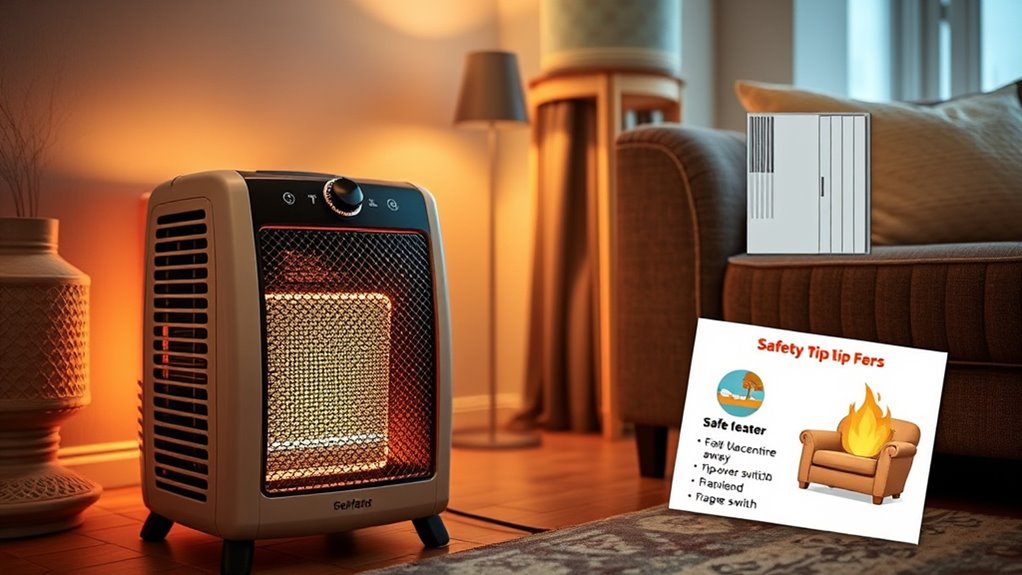
Knowing how to identify safe and unsafe features on a space heater is crucial for preventing accidents. First, check the thermostat settings—safe heaters have adjustable thermostats to control temperature and avoid overheating. Second, inspect the cord safety; ensure the power cord is heavy-duty, undamaged, and not frayed or pinched. Third, look for features like tip-over switches and automatic shut-off, which turn off the heater if it tips over or overheats. Avoid heaters with exposed heating elements, loose wiring, or flimsy cords, as these pose fire risks. By recognizing these features, you can confidently select safe models and reduce hazards in your space. Remember, maintaining proper cord safety and adjustable thermostat settings are key to safe operation. Additionally, vital safety features such as overheat protection can significantly improve your space heater’s safety profile.
Proper Placement and Usage for Maximum Safety
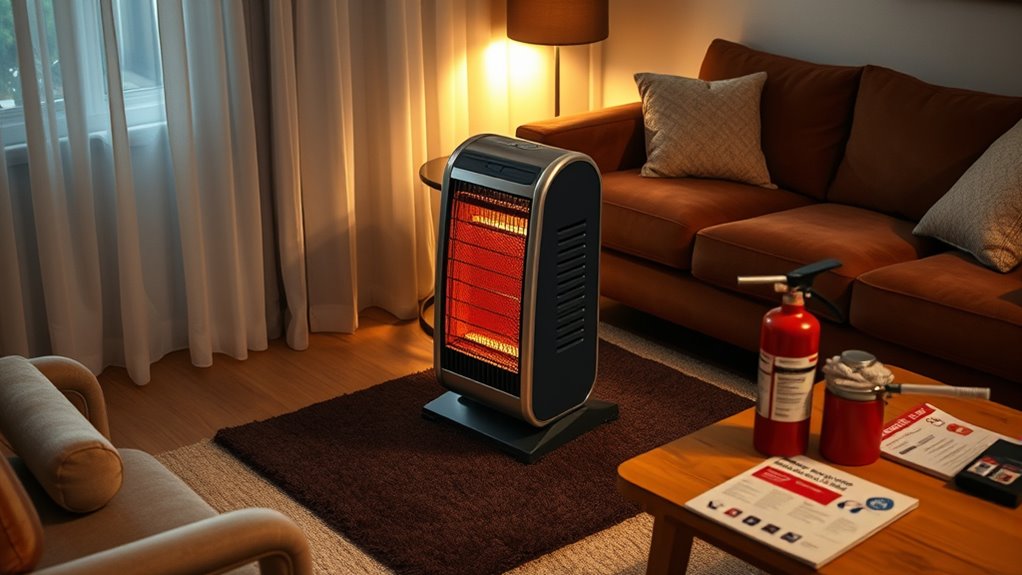
To guarantee maximum safety when using a space heater, proper placement is essential. Position the heater on a stable, flat surface away from high-traffic areas and combustible materials. Ensure that vents are unobstructed to allow proper airflow and prevent overheating. When designing thermostats, place sensors away from direct heat sources to get accurate temperature readings, avoiding false triggers that could cause unsafe operation. Keep the heater at least three feet from curtains, furniture, or bedding. Never block vents or airflow outlets, as restricted vent placement can lead to overheating and fire hazards. Regularly check that the heater is stable and not in a location where it might be knocked over or cause damage. Proper placement minimizes risks and guarantees safe, efficient heating. Additionally, using sustainable heating practices can help reduce environmental impacts associated with traditional space heater use.
Understanding Energy Efficiency and Cost-Saving Tips
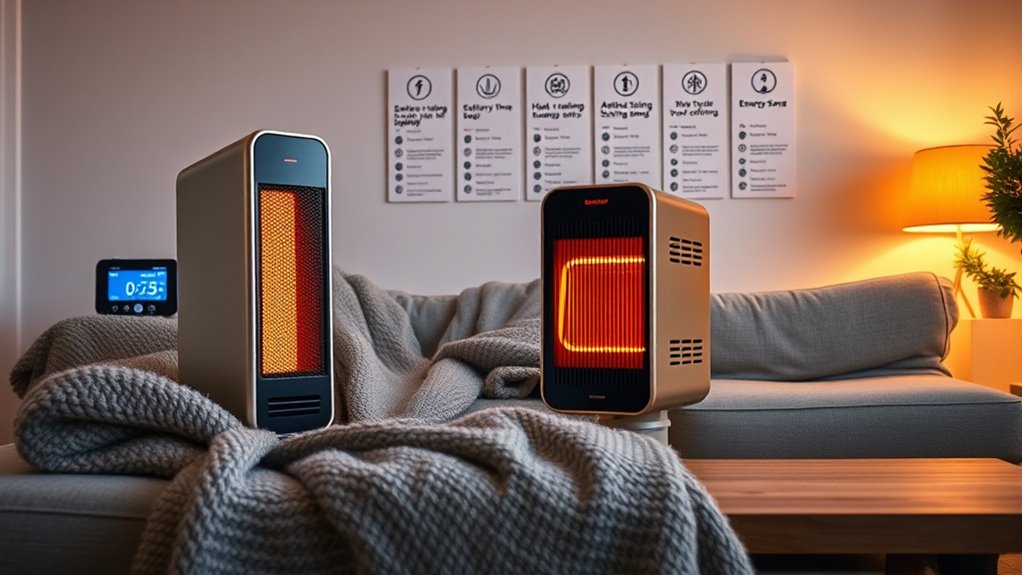
Maximizing your space heater’s energy efficiency can substantially reduce your heating costs while keeping your home cozy. To boost energy conservation and cut expenses, consider these tips:
- Use a programmable thermostat to heat only when needed, avoiding unnecessary energy use.
- Seal drafts and insulate windows to prevent heat loss, ensuring your heater works efficiently.
- Choose the right size heater—too large wastes energy, while too small might not warm your space effectively.
- Regular maintenance and cleaning can improve efficiency and extend the lifespan of your heater, contributing to overall safety and savings. proper maintenance practices
Fire Risks and How to Minimize Them

While space heaters can keep your home warm and cozy, they also pose potential fire risks if not used carefully. To guarantee fire safety, always place your heater on a flat, stable surface away from curtains, furniture, or other combustibles. Keep a safe distance of at least three feet around the heater. Avoid using extension cords, which can overheat and cause electrical hazards. Regularly inspect the power cord and plug for damage, and never operate a heater with frayed wires. Turn off the heater when leaving the room or sleeping. By following these precautions, you reduce the risk of fire and electrical hazards, helping you enjoy the warmth safely without unnecessary danger.
The Role of Maintenance and Regular Inspections
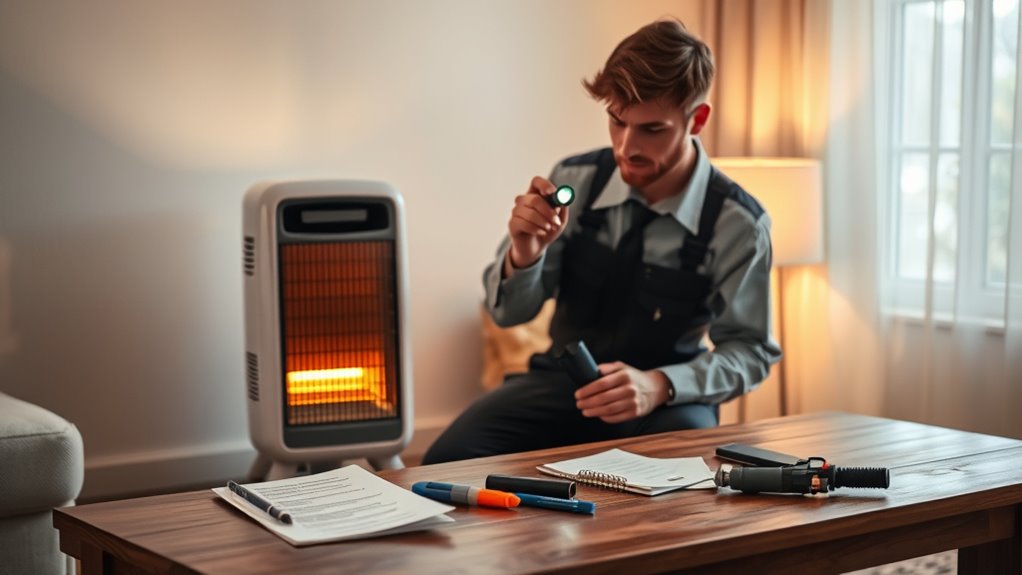
Regular maintenance keeps your space heater running efficiently and safely. You should schedule routine checks, clean the heating elements, and replace any worn parts promptly. These simple steps help prevent breakdowns and maximize energy savings. Additionally, inspecting the electrical connections regularly ensures there are no loose wires or potential hazards that could compromise safety.
Schedule Routine Checks
Scheduling routine checks is essential for keeping your space heater running efficiently and safely. Regular inspections help you catch potential issues early and ensure peak performance. During your check, focus on:
- Thermostat settings – Verify they’re accurate and functioning correctly to prevent overheating or wasting energy.
- Cord safety – Inspect cords for fraying, cracks, or damage, and ensure they’re not pinched or placed where they could trip or get damaged.
- General cleanliness – Remove dust and debris that could obstruct vents or cause overheating.
- Component integrity – Regularly examine internal parts for wear or corrosion to maintain optimal operation and prevent electrical hazards.
Clean Heating Elements
Keeping your heating elements clean is essential for maintaining your space heater’s efficiency and safety. Whether you use portable heaters or have a larger setup, dirt and dust can impair performance and increase fire risks. Regularly inspect and wipe down electric heaters to prevent buildup that can cause overheating. For gas heaters, ensure the heating elements are free of debris and carbon deposits. Remember, electric vs. gas heaters require different maintenance routines, but both benefit from clean components. Dusty or dirty elements reduce heat output, forcing your heater to work harder and consume more energy. By keeping the heating elements spotless, you prolong your heater’s lifespan, ensure consistent warmth, and minimize safety hazards. Regular cleaning also helps prevent automation-related malfunctions that could compromise safety. Make cleaning a routine part of your maintenance to master energy efficiency and safety.
Replace Worn Parts
Replacing worn parts is essential to maintaining your space heater’s efficiency and safety. When parts like filters, thermostats, or heating elements wear out, the heater may consume more energy, reducing energy conservation. Plus, damaged or dirty components can negatively impact indoor air quality by circulating dust or pollutants. To keep everything running smoothly, check these three areas regularly:
- Filters: Replace or clean filters to improve airflow and indoor air quality.
- Thermostats: Ensure accurate temperature control to avoid overheating and energy waste.
- Heating elements: Inspect for signs of wear or damage, replacing as needed for top performance.
AI detection methods continue to evolve, helping identify potential safety issues in appliances like space heaters.
Regular inspections and part replacements keep your heater functioning safely, saving energy and maintaining healthy indoor air quality.
Choosing the Right Space Heater for Your Home
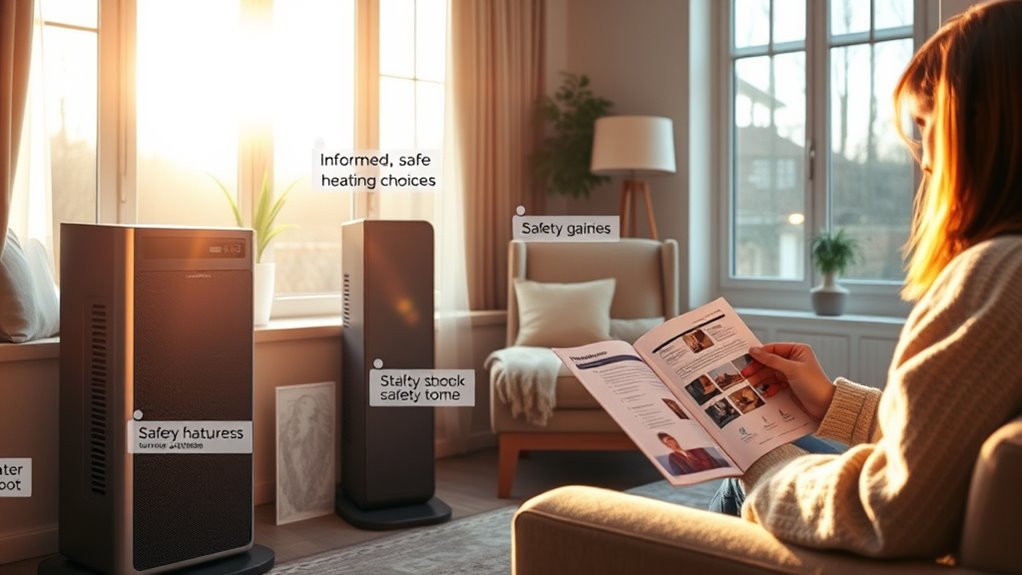
Choosing the right space heater depends on your home’s needs, including the type of heater that fits best. You should consider safety features to keep your family protected and make sure the heater is suitable for the room size. Getting these points right helps you stay warm efficiently and safely. Additionally, selecting a model with appropriate energy efficiency can help reduce long-term costs and environmental impact.
Heater Type Options
Selecting the right space heater depends on your specific needs and the space you want to warm. Your choice hinges on heater technology and energy sources. Here are your options:
- Infrared Heaters: Use radiant technology to directly heat objects and people, making them efficient for small rooms or spot heating.
- Convection Heaters: Warm the air through heating elements, ideal for whole-room heating in larger spaces.
- Oil-Filled Radiators: Use oil as a heat reservoir, providing steady warmth with energy sources like electricity, offering quiet, consistent heat.
- Considering the technology types available can help you choose a heater that maximizes energy efficiency and safety in your home.
Safety Features Importance
Safety features are essential when picking a space heater because they help prevent accidents and guarantee peace of mind. Modern safety feature innovations, like tip-over protection and automatic shut-off, have drastically improved heater reliability. These innovations make it easier for you to choose an energy-efficient upgrade without sacrificing safety. Look for heaters with features such as cool-touch exteriors, thermal cut-off, and overheat protection, which minimize fire risks. Prioritizing safety features ensures your home stays warm without compromising security. When you select a model with advanced safety options, you reduce the chances of mishaps and create a safer environment for everyone. Ultimately, investing in a heater with robust safety features gives you confidence and peace of mind during those chilly nights.
Room Size Compatibility
To guarantee your space heater works efficiently and safely, it’s important to match the unit’s size and heating capacity to the room you want to warm. First, assess your room’s size—larger spaces need higher wattage heaters, while smaller rooms require less power. Second, consider insulation installation; well-insulated rooms retain heat better, reducing the need for a powerful heater. Third, prioritize pets safety by choosing models with tip-over and overheat protection, especially if your pets are curious or active. Make sure the heater’s capacity aligns with your room size to prevent overheating or energy waste. Properly matching your heater helps maintain a cozy environment while minimizing fire risks, especially when considering insulation and pet safety.
Emergency Preparedness and What to Do in Case of a Malfunction
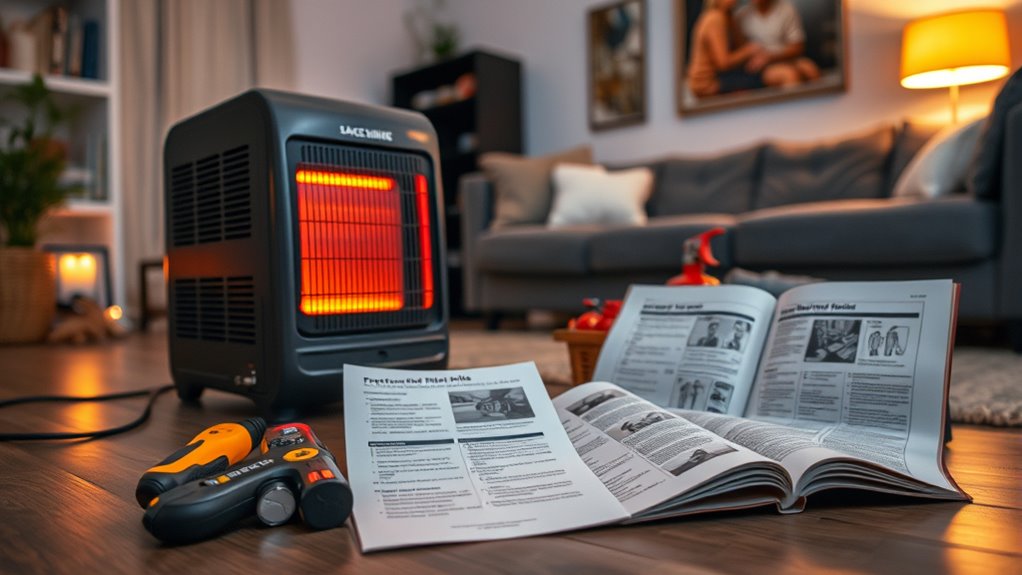
Have you ever wondered what steps to take if your space heater malfunctions unexpectedly? First, turn off the heater and unplug it immediately to prevent a fire. Next, confirm your fire escape route is clear, so you can evacuate quickly if needed. Keep an emergency kit nearby that includes a flashlight, first aid supplies, and a fire extinguisher. If you notice smoke, sparks, or burning smells, evacuate the room and call emergency services. Do not attempt to fix the heater yourself unless you’re qualified. Stay calm, and use your fire escape plan if the situation escalates. Regularly reviewing your emergency procedures ensures you’re prepared to handle malfunctions safely and swiftly, minimizing risks and protecting yourself and your home.
Resources and Expert Advice to Stay Informed

Staying informed about space heater safety and maintenance is essential, and you can do this effectively by leveraging trusted resources and expert advice. To dispel myth misconceptions and understand safety labels, consider these steps:
- Visit reputable websites like the U.S. Consumer Product Safety Commission for verified safety tips.
- Read manufacturer safety labels carefully—they highlight vital operating instructions and warnings.
- Consult with HVAC professionals or reliable experts if you’re unsure about common myths or proper maintenance routines.
Frequently Asked Questions
How Do I Identify Hidden Safety Features in My Space Heater?
To identify hidden safety features in your space heater, start by thoroughly reading the user manual, which details all safety functions. Look for features like tip-over switches, overheat protection, and cool-touch exteriors. Inspect the unit carefully for hidden safety elements such as automatic shut-off mechanisms or sensor-based safety systems. Feature identification also involves testing these functions when possible, ensuring your heater operates safely and efficiently during use.
Are There Specific Space Heater Brands Known for Superior Safety?
Did you know that over 70% of space heater fires stem from poorly made models? You should look for brands with a strong reputation for safety, like Dyson or DeLonghi, which prioritize safety certifications such as UL or ETL. These brands often incorporate advanced safety features, giving you peace of mind. Always choose a heater with certified safety standards, and read reviews to guarantee reliability before making your purchase.
Can Using a Space Heater Affect My Home’s Electrical System Safety?
Using a space heater can impact your home’s electrical safety if it exceeds the electrical load your circuits can handle. It may trip circuit protection devices, causing power interruptions or electrical hazards. Always verify your space heater is plugged into a dedicated outlet and avoid overloading circuits. Regularly check your circuit protection to prevent potential overheating or electrical fires, keeping your home safe while enjoying the warmth.
What Are the Signs That a Space Heater Is Malfunctioning?
If your space heater is malfunctioning, watch for signs like power cord issues, such as frayed or loose cords, which can be dangerous. Overheating indicators, like a strange smell, hot exterior, or frequent shutting off, also signal trouble. Always unplug the heater if you notice these signs, and avoid using it until you’ve checked or replaced problematic parts to guarantee safety.
How Often Should I Replace or Upgrade My Space Heater for Safety Reasons?
You should replace or upgrade your space heater every 3 to 5 years to guarantee safety. Regular heater maintenance and safety inspections help identify potential issues early. If your heater shows signs of malfunction, such as strange noises or poor heating, consider upgrading sooner. Staying proactive with maintenance and being aware of safety standards keeps you safe and ensures your heater operates efficiently over time.
Conclusion
Did you know that space heaters cause over 4,000 fires annually? By debunking myths, recognizing safe features, and maintaining your heater properly, you can keep your home safe and save money. Remember, a well-chosen and correctly used space heater is a reliable warmth source. Stay informed with expert advice, and always prioritize safety. With the right knowledge, you’ll enjoy cozy comfort without the risks—making your weekend mastery of space heater safety truly worthwhile.
